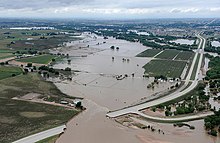Flood Risk Management: Difference between revisions
No edit summary |
No edit summary |
||
| (One intermediate revision by one other user not shown) | |||
| Line 11: | Line 11: | ||
<!--https://en.wikipedia.org/wiki/Flood--> | <!--https://en.wikipedia.org/wiki/Flood--> | ||
|caption= | |caption= Flooding on the South Platte River. | ||
([https://en.wikipedia.org/wiki/Flood Wikipedia]) | (Image Source: [https://en.wikipedia.org/wiki/Flood Wikipedia]) | ||
}} | }} | ||
Many dams are designed to help manage floods or reduce downstream flood damages. These dams often provide flood storage that retains and slowly releases flood water to reduce the peak flow in downstream areas. Flood control dams often go untested for years or even decades prior to the occurrence of a significant flood event when they experience their [[First Filling and Monitoring|first filling]]. Because of this, it is difficult to establish a performance record for these dams under flood pool conditions. This can make it difficult to identify deficiencies in advance of major flood loading events. | Many dams are designed to help manage floods or reduce downstream flood damages. These dams often provide flood storage that retains and slowly releases flood water to reduce the peak flow in downstream areas. Flood control dams often go untested for years or even decades prior to the occurrence of a significant flood event when they experience their [[First Filling and Monitoring|first filling]]. Because of this, it is difficult to establish a performance record for these dams under flood pool conditions. This can make it difficult to identify deficiencies in advance of major flood loading events. | ||
Dams built with the assistance of the [[Natural Resources Conservation Service]] provide almost $1 billion in annual flood damage reduction | Dams built with the assistance of the [[Natural Resources Conservation Service]] provide almost $1 billion in annual flood damage reduction benefits. Learn more about the Natural Resources Conservation Service's Watershed Protection and Flood Prevention Operations Program at [https://www.nrcs.usda.gov/sites/default/files/2022-08/NRCS_WatershedFloodPrev_Fact%20Sheet-2021.pdf this website]. | ||
Dams owned and operated by the [[Tennessee Valley Authority]] produce electricity and prevent an average of about $280 million in flood damage each year. | Dams owned and operated by the [[Tennessee Valley Authority]] produce electricity and prevent an average of about $280 million in flood damage each year. | ||
Latest revision as of 21:24, 28 March 2024

|
| Flooding on the South Platte River.
(Image Source: Wikipedia) |
Many dams are designed to help manage floods or reduce downstream flood damages. These dams often provide flood storage that retains and slowly releases flood water to reduce the peak flow in downstream areas. Flood control dams often go untested for years or even decades prior to the occurrence of a significant flood event when they experience their first filling. Because of this, it is difficult to establish a performance record for these dams under flood pool conditions. This can make it difficult to identify deficiencies in advance of major flood loading events.
Dams built with the assistance of the Natural Resources Conservation Service provide almost $1 billion in annual flood damage reduction benefits. Learn more about the Natural Resources Conservation Service's Watershed Protection and Flood Prevention Operations Program at this website.
Dams owned and operated by the Tennessee Valley Authority produce electricity and prevent an average of about $280 million in flood damage each year.
Revision ID: 7832
Revision Date: 03/28/2024
